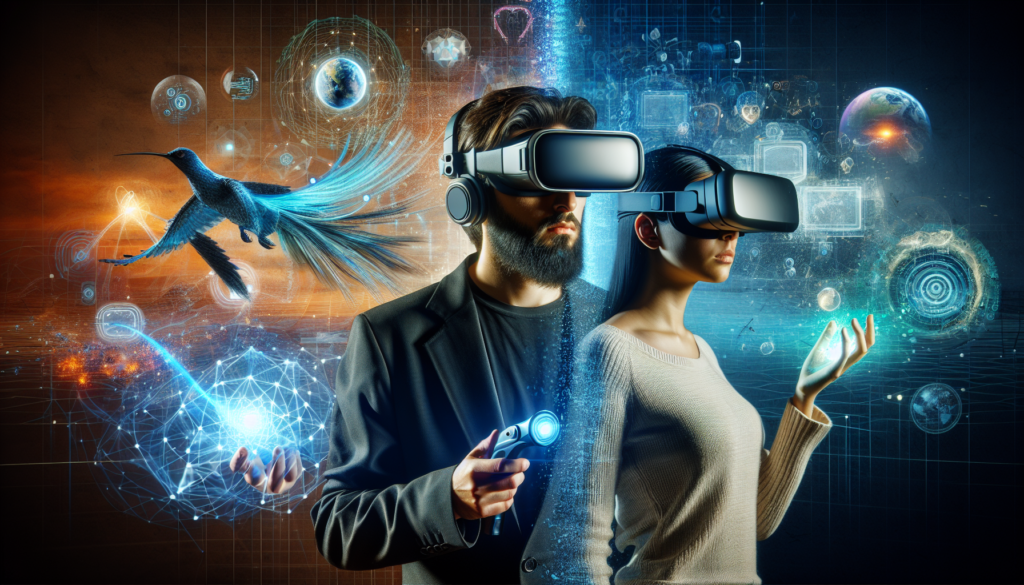Have you ever wondered what happens when two incredible technologies collide? Well, imagine a world where Augmented Reality (AR) and Virtual Reality (VR) join forces, creating an entirely new and mind-boggling experience. It’s like stepping into a whole different dimension, where you can not only see but also interact with virtual objects seamlessly blended into your reality. This mesmerizing combination is referred to as Mixed Reality (MR)—a groundbreaking technology that merges the best of both AR and VR to transport you to a realm where imagination knows no bounds. So, are you ready to venture into the extraordinary world of MR?
What Is AR And VR Together Called?
When it comes to the world of technology and immersion, two terms that often come up are AR and VR. But have you ever wondered what happens when these two powerful technologies are combined together? Well, the result is known as Mixed Reality (MR). Mixed Reality is a term used to describe the merging of both Augmented Reality (AR) and Virtual Reality (VR) into a single experience. By blending the physical and digital worlds, MR opens up a whole new realm of possibilities. Let’s dive deeper into the world of AR and VR, understand their differences and similarities, explore their advantages and challenges, discover their diverse range of applications, glimpse into the future of this technology, and finally, grasp the concept of AR and VR together within Mixed Reality.

Overview of AR and VR
Before we dive into the intricacies of Mixed Reality, it’s important to have a solid understanding of its foundation components: Augmented Reality (AR) and Virtual Reality (VR). AR overlays digital information onto the real world, enhancing our perception and interaction with our surroundings. It’s like wearing a pair of special glasses that allow you to see the world with additional layers of information, such as virtual objects, text, or images. On the other hand, VR completely immerses the user in a simulated environment, shutting out the physical world and replacing it with a fully digital experience. VR headsets transport you to an entirely different realm, where your senses perceive a world that exists solely in the realm of virtuality.
Differences between AR and VR
While AR and VR both share the goal of altering reality in some form, they differ significantly in how they achieve this objective. The key difference lies in the level of immersion and interaction with the real world. AR supplements reality by adding virtual elements, allowing users to maintain their presence and engagement with the physical environment. In contrast, VR creates an entirely synthetic environment, requiring users to be fully immersed and disconnected from the real world. Another notable distinction is the hardware used. AR often relies on smartphones, tablets, or smart glasses, while VR typically utilizes head-mounted displays or virtual reality systems. Understanding these differences helps us appreciate the unique characteristics and functionalities of each technology.
Similarities between AR and VR
While AR and VR have their differences, they also share several similarities. Both technologies aim to provide users with immersive experiences that extend beyond the bounds of the physical world. Whether it’s through AR or VR, a user can be transported to different places, explore new worlds, or interact with virtual objects. Both technologies rely on computer-generated graphics and often require powerful processors to ensure smooth and realistic experiences. Additionally, AR and VR have found applications in various sectors, including entertainment, education, healthcare, architecture, and more. Despite their disparities, AR and VR are united in their ability to push the boundaries of our reality and offer novel experiences.
Advantages of AR and VR
AR and VR hold immense potential and offer numerous advantages in various domains. One of the primary benefits of AR is its ability to enhance the real world, augmenting our everyday experiences with virtual information. It can assist users in carrying out tasks, such as navigation, by providing visual cues in real-time. For instance, you can use AR-powered maps on your smartphone to identify nearby points of interest. Similarly, VR enables us to immerse ourselves in fictional or artificial environments, creating surreal experiences that are hard to replicate in the physical world. VR has been widely utilized in gaming, enabling players to step into fantasy realms and interact with virtual characters, objects, and environments. Both AR and VR have revolutionized training and education by providing immersive learning environments that simulate real-life situations, helping individuals develop practical skills in a safe and controlled setting.

Challenges of AR and VR
While the possibilities and advantages of AR and VR are vast, these technologies also face their fair share of challenges. One significant challenge is ensuring seamless and realistic user experiences. Achieving high levels of realism in AR and VR requires sophisticated hardware, powerful processors, and accurate tracking systems. Furthermore, there are concerns about privacy and data security with the extensive use of AR and VR. As these technologies become more integrated into our daily lives, it is crucial to establish robust regulations and protocols to protect user information. Another obstacle lies in the cost and accessibility of AR and VR devices. As with any emerging technology, the initial costs can be prohibitive, limiting access to a broader audience. Overcoming these challenges requires continuous innovation, research, and collaboration among various stakeholders.
Applications of AR and VR
The applications of AR and VR span across a wide range of industries. In the field of healthcare, these technologies have been instrumental in medical training, patient rehabilitation, and even aiding in surgical procedures. Surgeons can utilize AR overlays during operations to access vital information without diverting their attention from the patient. VR has revolutionized architecture and design, allowing professionals to visualize and interact with their creations before construction begins. AR and VR have also found their place in the entertainment industry, offering captivating experiences in gaming and interactive storytelling. Moreover, these technologies have immense potential in education, providing immersive and engaging learning environments for students of all ages. From simulated science experiments to historical reenactments, AR and VR redefine the classroom experience.
Future of AR and VR
The future of AR and VR is exciting and holds immense promise. As technology continues to advance, we can expect further enhancements in the visual and auditory aspects of both AR and VR, resulting in even more realistic experiences. The ongoing development of lightweight and more affordable devices will make AR and VR accessible to a broader audience, reaching beyond early adopters. Additionally, advancements in haptic feedback and sensory stimulation will contribute to a more immersive and interactive experience. Furthermore, the integration of AI and machine learning algorithms will enable AR and VR to provide personalized and contextually relevant information to users. With these advancements on the horizon, we can anticipate AR and VR becoming an integral part of our daily lives, transforming how we work, learn, play, and interact with the world.
AR and VR Together
Mixed Reality, or MR, is the culmination of both AR and VR technologies into a single, cohesive experience. MR takes the virtual elements of VR and merges them seamlessly with the real world, creating a truly immersive and interactive environment. Imagine wearing a pair of smart glasses that not only superimpose virtual objects onto your surroundings but also enable you to interact with them as if they were tangible physical objects. This is the essence of MR. By integrating the best of both AR and VR, MR opens up a realm of limitless possibilities. Users can manipulate and interact with virtual objects while still maintaining their presence in the real world. MR has the potential to revolutionize industries such as gaming, design, architecture, and even remote collaboration, bridging the gap between the physical and digital realms like never before.
What is AR?
Augmented Reality (AR) is a technology that superimposes virtual elements on the real world, enhancing our perception and interaction with our surroundings. AR allows users to see and interact with virtual objects, images, or text integrated seamlessly into their physical environment. This is typically achieved through the use of smartphones, tablets, or specialized smart glasses. AR has found extensive applications in various fields, such as entertainment, marketing, retail, and education. Whether it’s trying out virtual furniture in your living room or exploring historical landmarks through your smartphone camera, AR has transformed the way we experience and engage with the world around us.
What is VR?
Virtual Reality (VR) is a technology that completely immerses users in a simulated environment, shutting out the physical world and replacing it with a fully digital experience. Through the use of headsets or VR systems, users are transported to a virtual realm where they can interact with virtual objects, navigate through virtual worlds, and experience sensory stimuli that mimic real-life scenarios. VR has gained significant popularity in the gaming industry, as it enables gamers to step into virtual worlds and interact with characters and environments on a whole new level. However, VR also has practical applications in training, therapy, and design, offering realistic and immersive experiences that surpass the limitations of traditional mediums.
In conclusion, the combination of AR and VR into Mixed Reality (MR) opens up a whole new dimension of possibilities. Mixed Reality seamlessly merges the virtual world with the real world, offering a truly immersive and interactive experience. AR enhances our perception of reality by overlaying virtual elements onto our surroundings, while VR transports us entirely to a simulated environment. Both technologies have their unique advantages, challenges, and applications across various industries. As technology continues to advance, the future of AR and VR looks promising, with even more realistic and accessible experiences on the horizon. So, embrace the realm of AR and VR, and get ready to step into the world of Mixed Reality where the boundaries of the physical and digital intertwine in extraordinary ways.
